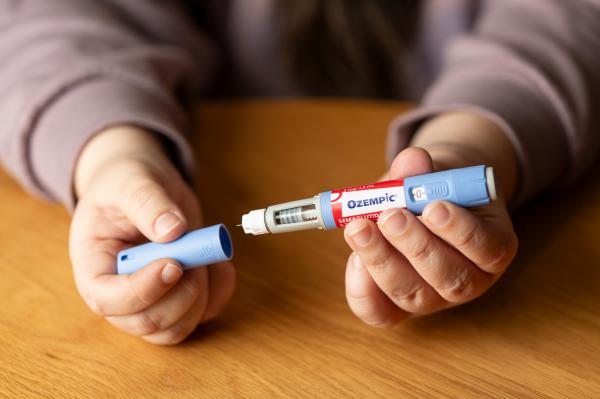
Weight Loss
The Size of the Problem
Since 1993, the number of people living in the UK with obesity
(BMI ≥ 30 kg/m2) has doubled, from 14.9% to 28%, and that number continues to rise. The health risks of obesity are staggering. They include: diabetes, heart attack, stroke, sleep apnoea, and arthritis. Death from any cause is far higher in those living with obesity, with associated comorbidities piling enormous strain onto an increasingly challenged NHS. Public health initiatives thus far have done little to tackle the root cause of obesity. The rise of Glucagon-like peptide-1 (GLP-1) and glucose-dependent insulinotropic polypeptide (GIP) agonists for obesity, more popularly known by their brand names Ozempic, Wegovy and Mounjaro, has been a fascinating and transformative development in healthcare, with some suggesting that they could be solution to the obesity epidemic.
What are Ozempic, Wegovy and Mounjaro?
The prescription medication Ozempic is an injectable medication taken once a week approved to help control blood sugar in individuals with type 2 diabetes but Ozempic has developed brand name recognition and almost cult status for its weight loss effects. The main ingredient in Ozempic is semaglutide, which is now also approved under the brand name Wegovy to treat obesity and overweight in individuals with co-existing, weight-related risk factors such as high blood pressure, high cholesterol and type 2 diabetes. Mounjoaro is the latest in the line of these effective medications with the main ingredient, Trizepatide, which is approved for both the treatment of type 2 diabetes as well as chronic weight management and has been shown in some clinical trials to have a greater impact than Ozempic on glucose control and weight. The weight-loss benefits of these medications have become so evident, their increasing approval and use for chronic weight management across the globe has been phenomenal.
These medications mimic the effects of these naturally occurring hormones glucagon-like peptide-1 (GLP-1) and glucose-dependent insulinotropic polypeptide (GIP), collectively known as incretins due to their role in stimulating insulin secretion after meals. They help regulate blood sugar, and how quickly your body digests food and how quickly your stomach empties. They help reduce appetite and increase satiety, thus controlling hunger and cravings. They assist with portion size control and how much you eat, leading to decreased calorie intake.
There are also other effects at a cellular level at the liver, the pancreas, and different types of fat cells especially the visceral fat cells often considered to be the “bad” fat cells. These effects are also known to support weight loss and their beneficial effects.

Why are weight loss injections rising in popularity?
There are several reasons for the increasing use of these medications. Compared to earlier weight-loss drugs, these agents offer significantly higher average weight loss (15-25%). Studies suggest they can also improve diabetes control and reduce cardiovascular risks associated with obesity and improve health outcomes in people with type 2 diabtes. More recently, the SELECT trial demonstrated a 20% reduction in the risk of heart attack, stroke, and cardiovascular death with semaglutide in individuals without diabetes and these medications could play a significant role in preventing cardiovascular events in a wider population, not just those with diabetes. The weight loss likely contributed to the observed cardiovascular benefits alongside improved metabolic markers like blood sugar and cholesterol levels.
These newer generation agents are injected weekly offering a simpler regimen than older medications. There is also shifting public perception and growing awareness of obesity’s health impact and acceptance of medical interventions for weight management contribute to the increase in demand.
However, its impact on aesthetics has also garnered significant attention, sparking discussions about both positive and potential negative changes. Weight loss can result in a slimmer overall physique, which some may find aesthetically pleasing. In some cases, weight loss from these agents can accentuate facial features by reducing puffiness and highlighting bone structure. Defined jawlines, cheekbones, and even sharper noses can be perceived as aesthetically desirable. Weight loss and perceived improvements in appearance can positively impact self-esteem and confidence. Even more importantly, the positive mental health impact from increased energy levels, improved mobility, decreased arthritic pain and the restoration of the ability to do day to day things that could not be done due to carrying excess weight cannot be underestimated. The significant weight loss achieved by some can be life changing. They offer powerful weight-loss potential and could change how we approach managing obesity which is a complex and widespread condition.

The Challenges
As with all things there are challenges and these include cost and access. These medications can seem expensive but patients report that the resulting appetite control can have an indirect positive financial impact as people find that they eat less and indulge less. This often offsets the cost of the medical therapy meaning that these treatments are often more affordable than people realise. Most people that do pursue medically supported weight loss are very motivated and see this as investing in their own health.
The high demand for these medications has caused a ripple effect across various facets of healthcare, society, and even the economy. The popularity of these medications has attracted excessive media attention and potentially led to unrealistic expectations regarding their efficacy and ease of use. This has in some instances fuelled misinformation and unhealthy weight loss practices. The illegal sale and use of GLP-1 agonists and other fake products has also become a serious public health concern with numerous FDA and MHRA warnings. Black market versions have been identified as being diluted, ineffective, or even dangerous, containing harmful contaminants or incorrect dosages. The ease of purchasing medications online, often through unregulated websites, makes it easier for individuals to unknowingly acquire fake products and many people are not aware of the dangers of fake medications or how to identify them, making them vulnerable to scams. It is important that people only obtain these medications from healthcare providers and not buy medications online from unknown or unregulated websites. If a deal seems too good to be true it probably is.
While generally well-tolerated, nausea, vomiting, and gastrointestinal issues can occur. Without proper medical monitoring and support, individuals may experience severe side
effects from improper use or interactions with other medications. Most side effects are transient occur at the time of initiation and dose escalation and can easily be managed with the right clinical support. For further information read our FAQs page at
www.drfranks.co.uk and from the Summary of Product characteristics for Wegovy and Mounjaro.
Along with health headlines and celebrity chatter of semaglutide’s weight loss effects has come the observation that losing weight rapidly can lead to changes in facial appearance – colloquially called “Ozempic face.” The term refers to the effect that rapid weight loss can have on a person’s face. These medications can cause effective and rapid weight loss and this happens across the entire body where any stores of fat are, including the face and can result in the skin appearing to be sagging and hollowed out. It is the weight loss and the rate of weight loss, rather than the medication itself, that causes changes in a person’s facial appearance and it is not something that happens to everyone and should be avoidable if the weight loss is more gradual and supervised. There are numerous aesthetic interventions that have become popular in helping with these changes. Afterward, the term “Ozempic butt “followed, which is used loosely to describe various changes in the buttocks associated with weight loss from these medications. These changes could include a flatter or deflated appearance due to reduced fat in the buttocks and sagging skin, particularly in individuals with pre-existing laxity or older age. Genetics, pre-existing body composition, and overall weight loss amount can play a role. While the aesthetic impacts are a valid topic of discussion, it’s crucial to approach it with nuance and caution. Ultimately, the most important aesthetic impact should be a healthier and happier you.
Doing it right
The significant, beneficial effects of these medications aren’t absolute. They provide a powerful initial push, but long-term weight loss depends on learning and maintaining healthy eating and exercise habits. People can still overeat if they don’t develop healthier eating habits. So how does the body react to the sudden removal of these medications? Research suggests that patients regain their weight back after the medication is stopped suddenly and if insufficient behaviour and lifestyle changes have not been made. For sustainable results behaviour change is crucially important when using these medications for obesity management, and successful weight loss hinges on this integration. Learning portion control and healthy food choices can minimise nausea, vomiting, and other digestive issues that sometimes lead to the side effects that are associated with GLP-1/ GIP agonists. Patients often discontinue treatment at an early stage when side effects occur and they cannot get the support and advice they need to manage what are often transient side effects that disappear after they are stabilised on a higher maintenance dose. This is one of the downsides to some online services that do not have a human interface.
.jpg)
Behavioural changes, like adopting a nutritious diet and regular exercise, lead to better long-term health outcomes beyond weight loss, including managing diabetes and cardiovascular risks and developing skills for self-regulation and making positive choices can boost self-confidence and emotional well-being.
Examples of helpful behaviour changes include dietary modifications like prioritising whole foods, vegetables, fruits, and lean protein while reducing processed foods, sugary drinks, and unhealthy fats. Mindful eating practices are a significant part of a person’s weight loss journey with medical interventions. Practicing slow, mindful eating to recognise satiety cues and avoid overindulging are a path to success. Using smaller plates, planning meals, and learning appropriate serving sizes are key.
One cannot emphasise enough some form of regular physical activity such as even engaging in moderate-intensity exercise for at least 150 minutes per week. Finding healthy coping mechanisms for stress, which can trigger emotional eating are also very relevant in those that seek help with obesity. Working with a team of medical professionals with dietitians, nutritionists, health coaches can provide personalised guidance, motivation, and accountability. Joining support groups or online communities can offer inspiration and connection with others on similar journeys. Remember these medications are a tool and not a quick fix. Behaviour change is the key to unlocking their full potential for sustainable weight management and improved overall health.
Overall, the high demand for these medication presents a complex picture with both benefits and challenges. While it’s encouraging to see these medications improving health outcomes for many, at a societal level ensuring equitable access, managing costs, and addressing broader issues such as food insecurity, systemic inequalities, and lack of access to healthy environments remain crucial considerations to fully harness the potential of newer therapies to tackle the global obesity epidemic.
Do you run an aesthetic clinic? Sign up for Dr Frank’s Weight Loss Method to offer your clients this unique groundbreaking approach that's changing lives every day, and earn 8% in referrals if you mention "Consulting Room".
Visit Dr Frank’s Weight Loss Method for more information or call 0331 630 1010.
